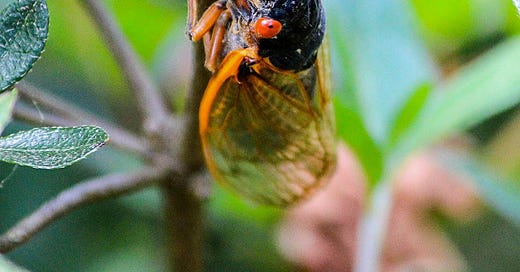It’s spring! At least temporarily. At least on the east coast. It’s my understanding that by Tuesday, it could be snowing. In the meantime, though, I think I saw two osprey — osprey! — flying in my DC neighborhood. I’m not sure if they were courting or fighting for dominance, but I was able to capture this one before it flew off in hot pursuit of the other.
We’re used to a certain amount of uncertainty in spring: should I wear a tank top? Should I wear a parka? Why don’t any of my coats work for this weather?
Every year, we experience weather setbacks, but it’s not every year that we collectively experience mood setbacks too. Vaccines feel optimistic, flowers blossom, hospitalizations shrink — and then again, here comes the pessimism, the snow, the variants, the uncertainty.
I’m here to offer a few sure things this week, some pretty incredible, bet-your-bottom-dollar nature shows that are either just starting or just about to start.
Spring Migration
First, an annual event, but no less amazing for that: spring migration has started, y’all! The Cornell Lab has forecast and live migration maps for the migration, so you can watch the birds’ movements as they travel.
If you do spot some birds during their migration, but aren’t sure about IDing them, the Cornell Lab also has a very handy bird ID website and app.
You can keep track of your list of birds you’ve spotted at eBird — or you can look at other birders’ lists to find promising local birding spots.
Brood X
Image by JamesDeMers from Pixabay
People may have mixed feelings about this second one, but I’m extremely excited. One of the largest broods of cicadas in the U.S. — and the one with the coolest-sounding name — Cicada Brood X emerges this summer.
According to the University of Connecticut’s cicada website (which features an excellent map of where the cicadas are expected to emerge):
Brood X is neither the easternmost nor the largest of the broods. Even so, Brood X is among the largest (by geographic extent) broods of 17- year cicadas.
If you live in Georgia, Alabama, or another southern state, you could start seeing cicadas as soon as the end of March. The emergence will creep northwards as spring progresses, with Washington, D.C., Virginia, and Maryland in the epicenter of this exoskeleton-abandoning insect bomb.
“It’s going to be pretty remarkable, come the latter half of May,” [Mike Raupp, a University of Maryland entomologist] said. “The densities of these things is going be phenomenal, about 1.5 million per acre. It blows your mind.”
One great place to go to get your cicada questions answered is the CicadaMania website. For instance:
Why do they stay underground for 17-years? The prevailing research suggests they’ve evolved a long, 17-year lifecycle to avoid predators that can sync up with their lifecycle & emergence. Why are there so many?! Research suggests that their huge numbers allow them to overwhelm predators, so enough of them will live on to breed and perpetuate the brood.
And if you’d like to contribute to cicada science, consider downloading the Cicada Safari app and letting scientists know where you spot these critters — or perhaps more relevantly, at the height of it, where you don’t spot them.
These are strange times. It’s nice to know that, no matter what events might transpire in the human world, the cicadas are waiting, impatiently now, testing each drop of rain, each morning’s dew. It’s been seventeen years now, and they are ready for the world to see their glory.





Hannah-
Greetings. Don't know how to "Reply to author" on the Fab listserv, and I don't know your last name -- so I can't readily find your e-mail address on the Fab membership list; therefore I'll post here, to thank you for sharing on the listserv your nature blog or newsletter.
(I could also share my own website, that includes my essays or articles about nature.)
Best spring wishes,
-C.K. (cicada killer? chosen kestrel?)